Why Was Roadhog Played Over Maintanks In The Overwatch League Playoffs?

The concept of main tanks has been a staple in Overwatch since its inception. We’ve all experienced those ranked games where your team lack a hero like Reinhardt or Winston to help your team create space to be able to push the objective. However, what if we told you that not only was that okay, but some of the best players in the world agreed that was the ideal strategy?
This exact situation is currently happening in the 2020 Overwatch League playoffs. The idea of main tanks has been challenged, as teams from all across the globe experiment with double-flex tank compositions that all feature Roadhog as the primary ingredient. Why has, or better yet how, has Overwatch’s favourite junkyard bacon-brawler become a professional staple? First, let’s dive into why we’ve seen so much of the war-hog.
Roadhog Sightings
There are a stack of reasons on why we’re seeing a sudden surge in Roadhog and a move away from traditional main tanks. Obviously, one main culprit is the recent Roadhog buffs that were applied in August 13 patch. These all increased his overall damage uptime while also increasing his overall DPS output. This, alongside the reduction of Orisa’s base armour on top of Sigma’s Experimental Barrier dropping in total health and regeneration rate, and you can start to see the thought process from the professional teams. If Orisa and Sigma are dropping in overall power, and Roadhog looks slightly better, then you could assume that Winston might feel a bit more dangerous. The obvious next step is to continue running Reinhardt, right?
Well, that relationship is complicated.

 Click to enlarge
Click to enlargeYou'd assume as much, however, consider this - if you're to run Reinhardt and Roadhog together, this predisposes you to a fairly close range brawl style, one that Sombra could prey upon. That on top of the Pharah changes that make her more mobile in the air and Reinhardt suddenly has an impressively difficult time getting anything done on maps with any kind of high ground. Sombra hacking ontop of Pharah displacing you or your team and spamming your shield and you've quickly got a problem on your hands. So, why not get creative? Take away the shields and allow for reasonably independent DPS heroes to flank and flight around the map, and add more pressure from your front line by using Roadhog to create space and support that with a Zarya or a D.Va.
As wild as it sounds, it's more potent than you might expect. The overall damage potential this archetype brings is insanely high, so much so that fights you should have no business winning with a normal composition, feel much closer and often the double-flex tank team can pull out a scrappy team fight.
As you might expect, Roadhog frequents Control maps by in large. However, if there is a submap that is more enclosed, we have seen teams, especially in the double-elimination bracket, opt into returning to Reinhardt compositions with some form of close-range support--think Junkrat, Mei, and Symmetra. Past Control, maps that feature narrow attack paths and a lack of high ground play into Roadhog's win condition. It's very difficult to be hooked and killed if you're on a roof somewhere. However, that's why Pharah synergises so well with this composition - she can help displace the backline to align them with her Roadhog and Zarya. While this all seems fine in practice, let's look at a few teams who've pioneered this strategy.
The Defiant Case
In Toronto Defiant's case, they were a few fights shy of toppling the Los Angeles Gladiators. Their weapon of choice throughout their exciting five-game set? Roadhog and Pharah, piloted by fan favourite DPS player Brady "Agilities" Girardi and rookie Thomas "zYKK" Hosono respectively. One of the league's most underwhelming teams nearly beat a team that looked promising coming into the playoffs, that's just how potent this composition can be, and the thesis to it is overwhelming pressure.
Here is a great example of how dangerous this composition can be. On the Defiant's attack against the Gladiators on Temple of Anubis, we see two things happening. First and foremost, Defiant want to create multiple paths of attack. In this first push, you'll see Andreas "Nevix" Karlsson and Andreas "Logix" Berghmans on the D.Va and Sombra respectively attack together while the rest of the Defiant plays as a split-core. Roadhog and Ana will play together on the plateau while Pharah and Mercy float above, keeping the roof between them and any potential long-range hitscan. Here we also see \the Gladiators have forfeited ground and are looking for their Wrecking Ball to slam the team as they show themselves on the plateau, however, there won't be much of a follow-up.

 Click to enlarge
Click to enlargeGladiator’s Tracer in this position will have to commit quite to find a grounded target that they can assassinate, the problem is that Toronto have positioned in such a way that makes it difficult for the Tracer to not press into very narrow chokepoints - which is incredibly dangerous.
Another thing to note here is where does the Gladiator’s Mercy go once the dive from Nevix and Logix comes in? Mercy is going to need an escape route, and both tanks for Los Angeles are soon to be committed towards the front of the fight, which puts her directly in the line of sight of both the enemy Pharah and Roadhog.
This is a fantastic example of these double-flex tank compositions overloading the fight, while also using the map geometry in a way that puts you at an advantage before the fight even starts. The Defiant goes on to win a fairly scrappy fight, but that’s almost to be expected. Obviously, you’d want to win clean, but with how much offensive power this composition has, you can trade a few heroes now for a team fight win later.
The Justice Case
Easily the biggest benefactor in this playoff patch and the new metagame has been the Washington Justice. For context, the Justice ended their regular season with four total wins. During the playoffs, not only did they sweep the Vancouver Titans and the Dallas Fuel to qualify for the double-elimination bracket but they took the defending champions, the San Francisco Shock, to game five and to top it all off, the Justice eliminated the Paris Eternal from the playoffs without dropping a map. Again it all comes down to pressure, and the Justice execute this extremely well.
The Washington Justice’s first map in their sweep of the Paris Eternal showcases this well. Again, referring back to our assessment of the Toronto Defiant’s composition - the idea here is for the double-flex tank team to open up as many attack paths as possible and to pile on the damage. This limits the space the Eternal can work within, and due to having a Reinhardt, they’re reliant on slowing pushing up with their tank and using the sightlines that he gives them to pick apart the enemy - or brawl head-first into them. The problem here is that Eternal can do neither of these two things well.

 Click to enlarge
Click to enlargeHere we see Lee "TTuba" Ho-Sung on Pharah, a signature hero of his, and he has the pick of the litter. Not only could he swing from the outside and pressure the backline, but he can pop in and out of the window to spam down the Eternal's Reinhardt. That's one line of pressure. Seeing the Eternal split their attention on Lee "Stitch" Chung-hee's Sombra, Jang "Decay" Gui-un can flank the front line and further drive the wedge between the enemy team. All the while Choi "JJANU" Hyeon-Woo is shredding the enemy Reinhardt's shield and keeping his eyes peeled for a misposition that he can punish with his Hook. All of these offensive threats makes it so difficult for Paris to get anything started. While they score the first few capture percentage, it almost doesn't matter, and the Justice are fine giving the space up to be able to sit back and take a favourable position to take the first team fight. That's why Paris are forced to play so passively.
All in all, the massive influx of Roadhog has left many scratching their heads. The power of the hero and the subsequent compositions comes from the added offensive pick threat with Hook, and the overall damage increase that having an added flex tank gives you. Combine that with more independent heroes, and you've got a recipe for disaster. The key and the solution we've seen arise in the playoffs is to bite the bullet with Winston and take the fight to the Roadhog. This puts the enemy team on the back foot and never lets them begin to start rolling the damage in their favour. If you don't attack first into this barrage of damage, then you'll only fall victim to the Roadhog hype train.
Images via Blizzard Entertainment
